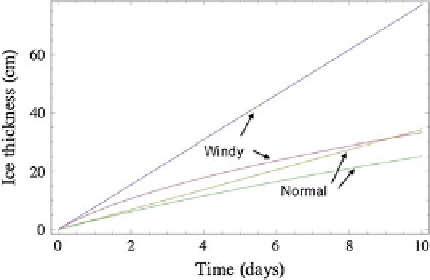Geoscience Reference
In-Depth Information
Fig. 4.10
Frazil ice
accumulation and congelation
ice growth at air temperature
held constant at
-
15
°
C.
Normal case refers to
climatological wind, and windy
case refers to doubled wind
speed. Frazil growth is
stronger, especially at high
wind
more than congelation ice growth. If the heat loss is 100 W m
−
2
, the resulting frazil ice
production rate is 2.8 cm day
−
1
. Accumulation of frazil ice in a turbulent boundary-layer
has been modelled by Omstedt and Svensson (1984) using a one-dimensional model. To
solving the full frazil ice problem one needs to consider also advection and consequently
take a two-dimensional modelling approach. Frazil ice models have been largely worked
on in river ice research (Lal and Shen 1993).
Example 4.8.
The model (
4.51
) can be extended to examine the open water question. For
q = 0, the equilibrium solution between the heat loss to the atmosphere and the heat
fl
ux
from the water body is
T
0
¼ T
a
þ
Q
w
þ
k
0
k
1
If T
0
> T
f
,
there is no frazil formation. The wintertime climatology shows that
40 W m
−
2
and k
1
*
15 W m
−
2
C
−
1
k
0
* -
°
(see Table
4.1
). In the presence of strong
ux, say, 190 W m
−
2
, we have T
0
= T
a
+10
geothermal heat
fl
°
C, i.e. a freshwater lake may
stay open down to the air temperature of
10
°
C. In the case of a hypersaline lake, say,
-
T
f
=
20
°
C, assuming Q
w
= 0, we have T
0
−
T
a
=
3
°
C. Thus the lake is open down to
-
-
the temperature of
17
°
C.
-
4.3.5 Melting
Analytic models of ice melting can be based on total absorption of heat by the ice changed
to decrease the volume of ice; then
represents the volume of ice per unit
area. This approach corresponds to the physical picture where signi
'
ice thickness
'
cant melting takes
place at both boundaries and in the ice interior. In many applications, simple models are
used where the rate of melting is proportional
to the positive degree-days of air



Search WWH ::

Custom Search